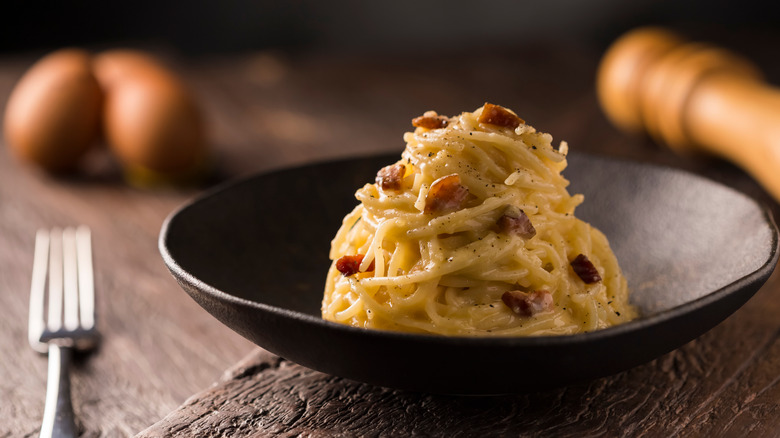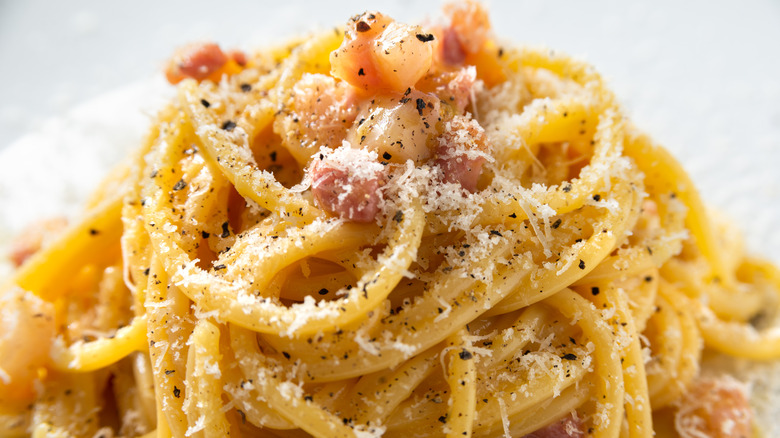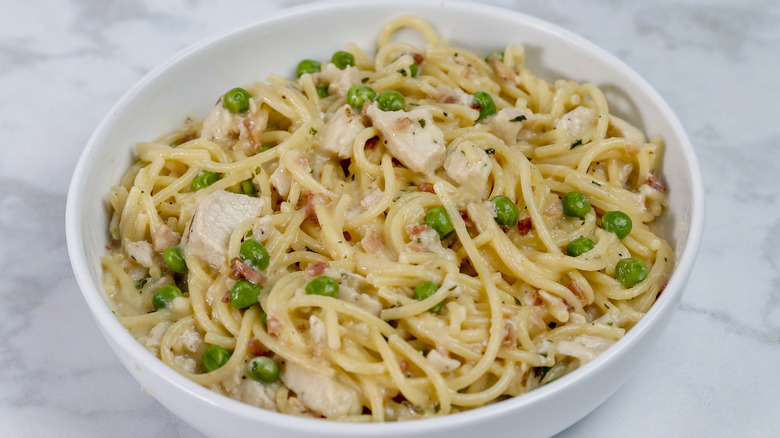The Controversial Difference Between American And Italian Carbonara
Ah, carbonara — those silky strands of pasta coated in rich and creamy sauce with nuggets of salty, savory, and utterly crispy pork in each bite — a much-beloved dish that has crossed borders, hopped continents, and sailed across waters to become a world favorite. Alas, like any dish that has traveled far through history and geography, carbonara is a dish of much global controversy, and there are two countries in the thick of it: Italy and America. The topics of dispute? The ingredients that define a carbonara and the country responsible for giving birth to the world-famous dish.
At its core, Italian carbonara uses three ingredients: eggs, pecorino romano, and guanciale (cured prom jowl) with black pepper (always ground fresh) and long pasta. Though some concede to pancetta (pork belly instead of jowl) filling in the shoes of guanciale and Parmigiano Reggiano replacing pecorino much to the chagrin of carbonara purists, the ingredients of an Italian carbonara remain more or less the same.
American versions, on the other hand, use more than the three ingredients that define an Italian carbonara. Aromatics like garlic and onion are used to flavor the sauce, an array of veggies like peas and mushrooms as well as proteins like chicken are thrown in, guanciale and pancetta are swapped for bacon, and the odd splash of white wine is poured in. Perhaps the biggest (and most controversial) difference between Italian and American carbonara, however, is the freehand use of cream in the latter.
Carbonara's origin is also a matter of dispute
While the additional ingredients and generous use of cream may be the biggest difference between Italian and American carbonara, another controversial matter is its invention. There are several legends as to how the saucy dish came to be. Some believe that carbonara is an entirely Italian dish, claiming that it was invented by the carbonari — Italian charcoal miners who would fill their baskets with cheap and long-lasting ingredients like eggs, pasta, and cheese that could be cooked over a fire while they were high up in the Apennine mountains. Others believe that the easy-to-find ingredients were vital in keeping members of the Carbonari sustained — an early 19th-century secret society in Italy that would whip up carbonara using meager resources while in hiding.
But the story of carbonara has taken a more complex turn. While there's no denying that pasta dishes made from some combination of eggs, pork, and cheese have existed in Italy for centuries, the first mention of a dish called carbonara didn't appear until 1952. More astonishingly, it appeared in an American book — a Chicago eating guide written by Patricia Bronté at that. According to some historians, this is because though carbonara was invented in 1944 by Italian chef Renato Gualandi, it was cooked for American and British soldiers stationed in Italy after World War II, using American rations of cheese, powdered egg yolks, bacon, and — you guessed it — a good splash of cream!
The controversy isn't limited to American carbonara
To say that the ingredients are a sensitive matter is an understatement. In fact, the controversy around this pasta is so fierce that its fallout isn't limited to just the American carbonara — even the domestic goddess Nigella Lawson once found herself in the thick of it. Lawson shared a recipe for spaghetti alla carbonara which featured the usual suspects — spaghetti, pancetta, eggs, parmesan, and black pepper — but with a few not-so-usual ingredients: white wine, nutmeg, and heavy cream.
Now these may not seem so unordinary for an American carbonara, but the backlash on her Facebook post was swift and brutal. "The classics of Italian cuisine deserve a little more respect," wrote one netizen as another argued, "You can certainly add the cream/wine (or whatever else you want) but don't call it 'Italian carbonara'." Head on over to Reddit to see that this isn't a unique situation. Yikes.
So contentious are the ingredients of a carbonara that London-based restaurant, Bottega Prelibato, decided to scrap the dish from its menu entirely after one too many people asked for ingredient modifications in their no-cream, no-chicken, no-mushroom, Italian carbonara. To make matters more intense, Italian carbonara purists are also at odds with French carbonara after a website published a recipe that featured bow-tie pasta cooked with onions, and creme fraiche in one giant pot. Worse still, the dish was garnished with a single raw egg yolk. The feud has even been given a name: Carbonaragate!



